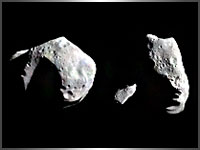
Researchers in the UK recently identified 12 small asteroids close enough to Earth to be used in mining operations that could begin as early as 2021.
The research was part of a larger effort by both private and public institutions to learn more about the potential for tapping into asteroids that could contain large deposits of valuable resources including platinum, iron-nickel ore or gold. Even if some of the resources were too expensive to carry back to Earth, certain minerals could be tapped to help refuel spacecraft already in orbit.
“If material or volatiles extracted from an asteroid could be used in space to feed an engine or to save launched mass from Earth — water for life support, for radiation shielding — the costs of space operations may drop considerably,” said Daniel Garcia Yarnoz, PhD Researcher at the Advanced Space Concepts Laboratory at the University of Strathclyde and the lead researcher on the paper.
Of course, mining for those precious and industrial metals far away from Earth comes with several challenges. One of the technical difficulties is to find “easily retrievable objects,” or EROs, that can be transported to Earth by changing their velocity by less than 500 meters per second. The EROs also must be maneuvered into an accessible orbit, meaning an L1 or L2 Lagrangian point, an area in space where the gravity of the Earth and the sun balance out.
Found 12
The researchers at the University of Strathclyde scoured a list of about 9,000 near-Earth objects and identified 12 that fit the criteria for possible mining. One of the asteroids, 2006 RH120, could be sent into orbit by changing its velocity by as little as 58 meters per second, according to the scientists, who said it could be done as soon as February of 2021. If it were set into motion then, the researchers calculated it could reach its destination in five years.
Since that mission would be on a smaller scale and using today’s technology, that is a realistic time frame, said Leslie Gertsch, senior research investigator and deputy director of the Rock Mechanics and Explosives Research Center at the Missouri University of Science and Technology.
“Retrieving an asteroid of 2-5 meters diameter is certainly realistic in that time frame, within the constraints laid out in the Yarnoz et al. paper,” Gertsch told TechNewsWorld. “Mining enough asteroids of that size to be economically viable is another thing altogether.”
NASA Wants In, Too
The research was released around the same time NASA announced plans for a mission designed to help scientists learn more about the resources and experience needed to mine asteroids. The OSIRIS-REx spacecraft is set to launch in September of 2016 and is expected to reach the asteroid Bennu in October of 2018.

Once there, it will scout the asteroid, looking for clues about its formation and the path of its orbit to better determine if mining could pose any threats to Earth. The OSIRIS-REx is then scheduled to return with samples from Bennu that will provide scientists with more clues about the possibilities for mining asteroids.
NASA’s effort, together with research that is currently under way, will aid scientists and potential investors in understanding both the challenges and possibilities associated with asteroid mining, said Gertsch.
“The biggest hurdles from the commercial perspective are poorly known costs and poorly known markets; both aspects must be well understood to make a viable case to investors,” she told TechNewsWorld.
“Technical questions center on ‘How much will it cost?’ rather than ‘How can it be done?’ In the beginning, it will be very expensive and inefficient. Costs will go down and efficiency will go up as experience is gained.”
Overcoming Obstacles
The overall lessons about space exploration that could develop from studying asteroids could also be a catalyst for helping interest and public funding in asteroid mining, said Garcia Yarnoz.
“Some of the main limitations can also be the driving forces or part of the solution,” he told TechNewsWorld.
“The cost per kilogram in orbit — of the order of US$10,000 — and the limitation in volume on a rocket fairing [are] pushing the industry either towards more efficient launch systems, smart deployable structures, and/or hopefully in the near future, in-site resource utilization,” Yarnoz explained.
“The synergies between other asteroid manipulation endeavors may also aid the growth in the industry,” he continued.
“The current threat posed by asteroids can spark international efforts to detect, catalog, monitor and characterize the asteroid family of NEOs,” Yarnoz observed. “Several deflection techniques, such as laser ablation, have additional applications for opportunistic science or material extraction. Their development could kill two birds with one stone.”






















































I AM not understanding the technique yet the concern is who will regulate this and what danger does it pose. I believe it is dangerous to move asteroids that could become meteors. The safety of our planet out ways any benefit. There should be safe systems built in and greed should not be the motivating factor. There have been movies made about this stuff. We should also have contingency plans- what to do if something goes wrong with the process.